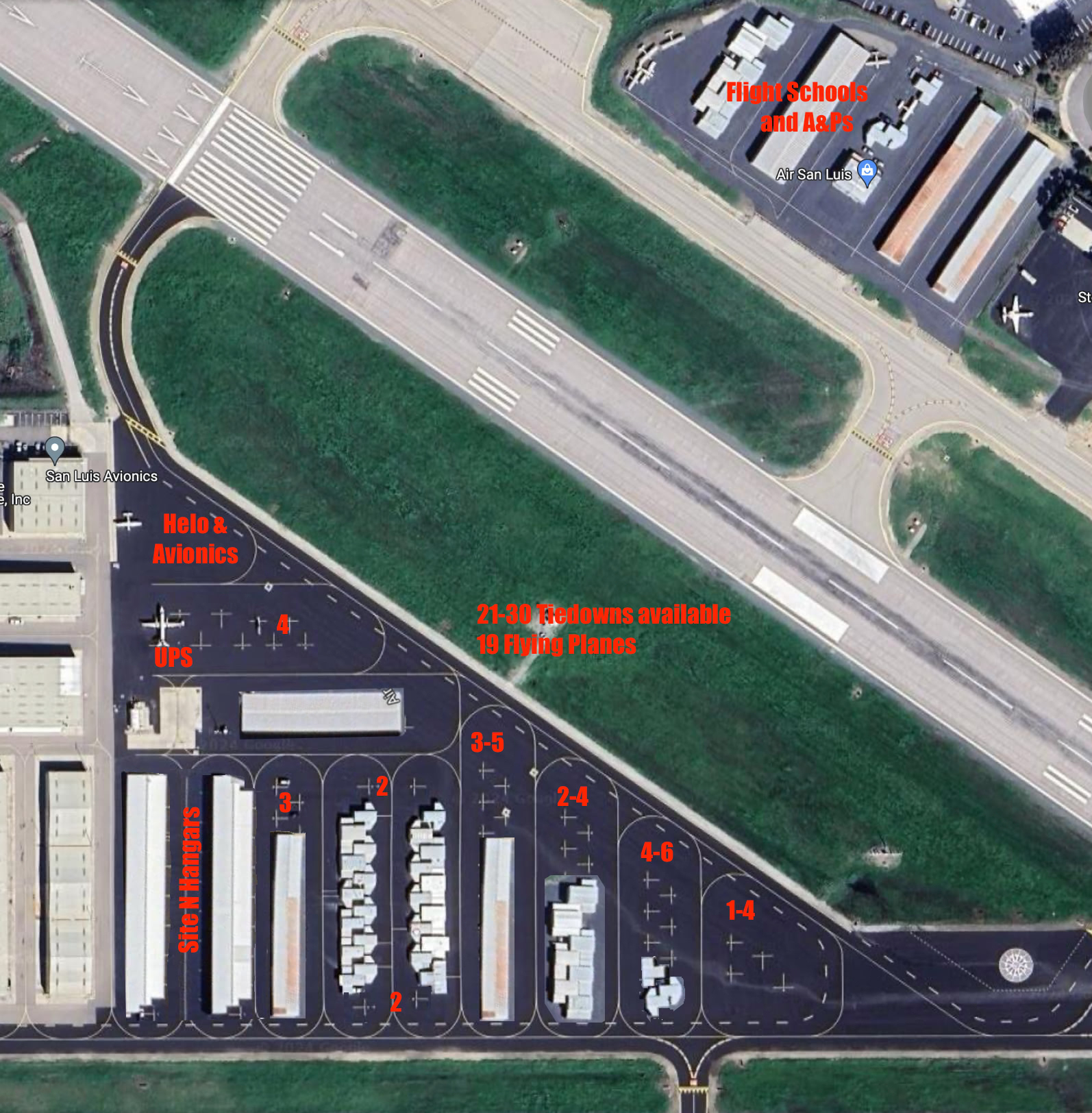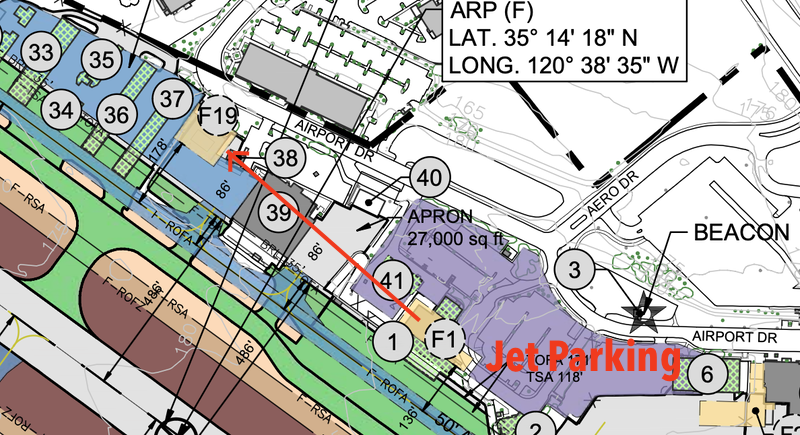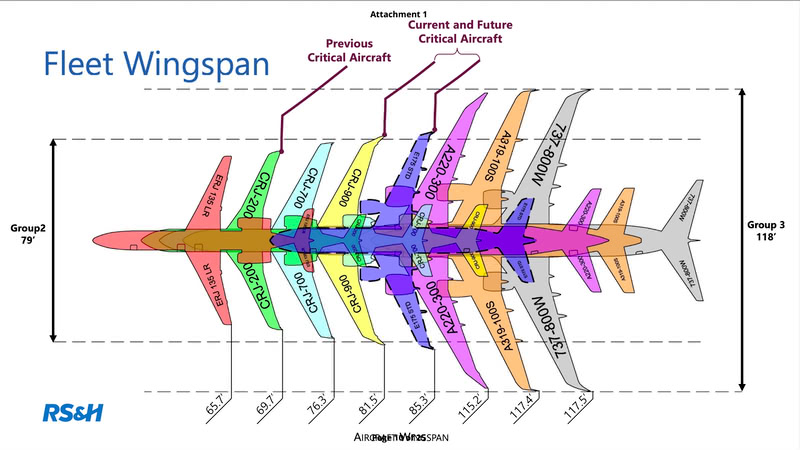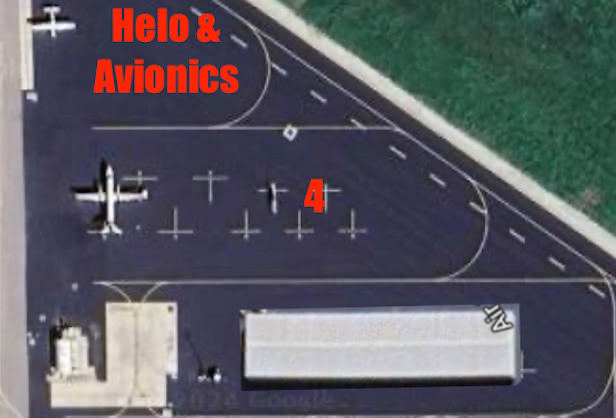Rescue Rwy 7/25 Workgroup
Objective: To outline a detailed proposal on the value of Runway 7-25, alternate scenarios that retain 7-25, and potential funding sources to support the maintenance of the runway over time.
Background:
Courtney positioned the removal of 7-25 as the only way to provide the desired hangar and other resources desired for GA. Erik Steeb explained the Rescue 7-25 group to her and its goal of creating thoughtful alternatives that would not require the removal of the runway. She sounded receptive and agreed that we could plug in representatives from each of our workgroups into their respective KSBP counterparts.
The airport took recommendation regarding Taxiway E into account in the revised AMP that was submitted to the FAA last June. Takeoffs will presumably be allowed from Taxiway E, since they are allowed now and the lengthening the runway will add about 700' to the takeoff distance.
Pros for Closing Rwy 7/25:
- Sort of simplifies the movement of approximately 70 airplanes and hangars from the Tower Side to the West Side.
- Allows for expansion of GA tiedowns if demand arises.
- Eliminates the need to find a funding source for repaving/resealing.
Cons against Closing Rwy 7/25:
- The cost of construction new hangars will be substantial.
- Removes an emergency runway if an airplane has an engine failure on takeoff from Rwy 11/29
- Removes an alternate runway when there are strong Santa Lucia crosswinds that make landing on Rwy 29 more difficult for small aircraft.
- Removes the ability to take off on Rwy 25 which eases wait time for pilots and simplifies control of aircraft for the tower.
- The tower would very much prefer to keep 7-25 and, as much as possible, shift closed-circuit operations, helicopter training, left-downwind (southerly) departures, etc to that runway. There is no problem with 7-25 pattern conflicting with 11-29 operations. (Northerly departures that would cross the Rwy 29 departure corridor so are not desired)
- Both SQL and PAO in the bay area are the same length or shorter than runway 25 so touch and goes should not be an issue.
- Were 7-25 to shut down, the airport would need to prohibit helicopter training during certain times, likely pushing Helipro off the field (to Santa Maria or another field)
- Phased relocation of the hangars at Site J and K would cause minimal disruption to airport operations and be significantly cheaper than new construction.
Definitions:
Tower Side - the side of the airport with the tower
Site November - the blue hangars owned by the county
Site Mike - ACI
Sites J and K - the hangars around Al’s shop. I assume that the two rows of long hangars are K and the rest J.
Site T - the pink hangars on the West Side
Site Q - The commercial hangars on the West Side
Site P - The three rows of hangars parallel to the runway
Strausburg hangars - the four rows of hangars at the end of Rwy 25
Things we know
- The leases for Sites J, K, and Al’s shop have expired and they are on a month-to-month basis. Al has been given a 60 day eviction notice. Sites J and K have not.
- The lease agreement for Site T contains a clause that allows the airport to terminate the lease with 365 days notice. The revised AMP for calls for the removal of the hangars at Site T.
ACCOMODATION OF MASTER PLAN DEVELOPMENT
C. In the event that County determines that all or any part of the Leasehold Area are needed consistent with the Master Plan, or that the current Leasehold Area will be vacated consistent with the Master Plan, County shall have the right to terminate this Lease by giving Association a 365 day notice. - The lease for Site Q specifically mentions that “Building B” (where San Luis Avionics is located) may have to be removed or remodeled. The revised AMP has a cutout for the edge of the building.
Assumptions:
- The surface of Rwy 7-25 has just been resealed and will last 5-8 years before needing maintenance.
- Funding for ongoing maintenance will have to be obtained from the county, the FAA, or fees from tiedowns and hangars.
- The county will pay for the movement of the two rows of hangars from Site N to the West Side.
Things to do:
- Total cost of the resealing of the West Side last year was $800,000. There is no breakdown of how much the runway portion cost. A rough estimate is that it costs $1 per sq foot or 2,500 x 100 = $250,000. We need to get a better estimate of the cost for reseal and the timeframe.
- Measure the hangars to see if the proposal works.
Questions that I would like answered by the airport.
The plan calls for an A&P/FBO behind the blast wall by the ACI maintenance hangar. Has that space been given to ACI?
When the hangars are cleared out of those sites are there any plans for the apron or is it being given to ACI?
In conversations with Al, it was assumed that he would be able to move his hangar to the back of the site, but the he’s been given an eviction notice. What is the plan for his shop?
Is there a timeline for clearing out Sites J and K?
Can the hangars be moved?
Can those that don’t infringe on the RSA stay?
Who will pay for any moves? They currently have no lease agreement and I assume that they will be responsible for any costs related to the move (or dismantling).
The cost of construction new hangars will be substantial. Will the airport be constructing and leasing them out as the did with Site N or will there be the opportunity for Hangar Associations to bid on the construction? What is the timeline?
Can we get a copy of the entire package for revised AMP that was submitted to the FAA last June including cost estimates?
Is there any provision for allowing commercial operations on the West Side other than on Site Q?
The current AMP calls for hangars alongside Rwy 7/25. Could we put shade hangars there?
The plan also calls for a building in the empty space at the entrance to the airport. Can that space be developed right now as commercial space?
Potential rearrangement that keeps Rwy 7/25.
It appears that it would be possible to move all of the airplanes and hangars from the Tower Side to the West Side with the exception of the 7 or so planes at the fight school.
There are two sets of numbers because I don’t know how far the ROFA and TOFA (obstacle free areas for the runway and taxiway) extend.

Original version 2024-06-19
Response-1
Paulo commented: I think cons (1) is not adequate. The cost of constructing new hangars will be substantial no matter where they are built.
I think we need to use arguments that resonate with the airport administration. They really don't care/understand the importance of runway 7/25 for safety or crosswind operations. They really don't care about helipro - unfortunately.
I think the reality behind all of this is that the airport administration sees of the west side and runway 7/25 an opportunity to build hangars, but they are not really for us, GA aviation. They are for bigger airplanes.
For GA, build more hangars where we now have tie-downs is probably enough. Build hangars beside 7/25 (like the old master plan) is also a possibility, but right now they can't fit big hangars in this area.
It is true that right now the county price for hangar space is only proportional to the area of the hangar, but I beat the county gets (or thinks they will get) way more renting a hangar for a corporate jet than renting 10 hangars for GA airplanes.
So, somehow (I don't have the answer, unfortunately) we need to come up with arguments that shows the county how they going to profit from keeping the runway 7/25.
That is my personal perspective. Curious to hear from you all.
It would make a whole lot more sense to move the Admin building to F19 and have Jet Parking and hangars where the old terminal and admin building are. ACI will be giving up 50x 1000'= 5,000 sq ft of apron and the area I propose using for airline and ACI jet storage is 30,000 sq ft. that would remove the need to move the hangars from Site N as well. It would also remove the need to relocate the control tower (which is not likely to happen anyway). There is also plenty of space for Jet Hangars behind the trash company in the purple area.

Addendum-1
I attended the ALUC today and Allan Settle had a few minutes at the end to talk about the changes being driven by the airline industry at the airport. The ALUC probably has no input into the planning process, they are just enforcers of the rules after the fact, but the Commission asked their attorney to look into what role the Commission has in the plan.
I asked the staff for a copy of the noise and safety zone maps because I couldn’t find them. However, the presentation by staff had them labelled, so I was able to find the map. Shifting the runway 740' and allowing takeoffs at Echo will shift the noise traffic pattern zone into the Laguna Lake area. Keeping Rwy 7/25 for takeoffs and landings will alleviate much of the noise in that area.
Response to Comments-2
Jim Ratcheck commented: I doubt if a purely economic argument can be made for 7/25. I’d suggest we just mitigate the costs of it. The arguments I would proffer:
1. Safety.
a. Far fewer runway crossings.
b. Departures from 25 involve no potential incursions on 29 and no crossing runway or taxiway conflicts.
c. Separation of heavy and light operations, on ground (jets blowing GA around) and in the air (wake turbulence). Show them the video of the LSA crash at SNA in wake turb [track] a couple months ago.
2. Expedite and prioritize airline traffic. If 25 disappears, airlines will be forced into line on Alpha with GA, and at this time it is often not possible for them to clear the runup area with GA traffic there. There are far more GA planes than airliners. Why not keep GA out of the way?
3. Climate/quality of life effects: The worst thing you can do is have airplanes taxiing and idling – wastes time, wastes money, pollutes. The re-arrangement of the airport to put GA on the west side and remove 25 is the worst case scenario for climate change, quality of life, cost and efficiency for both airlines and GA.
These are all hot button issues that can be effectively amplified with the right messaging and marketing approach and will iput pressure on them to not sacrifice safety, hurt the climate, slow down airlines.
Obviously, for us, safety, speed and efficiency may look different than what’s above, but since they are focused on airlines and corp jets, I’d suggest we stick to talking points that will resonate with “politically minded public servants”.
Response to Comments-2
Chris Isler commented: Well said Jim. I agree with that strategy very much.
On a side note, has anyone got deeper knowledge of the FAA reauthorization bill. I only know of what is in publications but it does included amongst other things irrelevant to our mission:
GA airport funding. Authorizes $4 billion a year for the FAA airport projects program, up from $3.35 billion most of this increase will go towards funding for GA airports
Transit parking ramps. Provides $34 million per year in small airport fund for construction of itinerant and transient GA parking
With the stratagy Jim proposed could the airport apply for funding in the name of safety between GA and commercial on the momentum of the new bill and increased funding.
I think of Long Beach as a perfect example. GA flow is a constant merry go round on 26L and commercial jets flow simultaneously in perfect harmony on 30.
Additional Question for Airport Staff - 1
John Scarry added: The airport was required to present the plan to the ALUC for a determination that the plan was “Consistent with the current Airport Land Use Plan. They did so at the May 13th 2023 ALUC Meeting. (Staff Report) The Commission voted on a resolution that said it was consistent with members voting favor except for Allan Settle. Two members Craig Piper and Adam Verdin recused. The SBP Airport Master Plan process is currently in the environmental determination phase to comply with the California Environmental Quality Act (CEQA), and it is anticipated that the environmental review process will conclude in winter 2023. Has that review been finalized?
Additional Question for Airport Staff - 2
John Scarry: Are cost estimates available for each of the items in the plan that was submitted to the FAA? What is the plan for construction of hangars on the West Side? Is it possible to get the entire plan for review?
Additional Question for Airport Staff - 3
John Scarry: This diagram in the plan indicates that the plan is designed for Group 2 aircraft yet there are three aircraft types that currently use the airport for regularly scheduled service that fit into Group 3. Does the plan need to be ammended to take the increased wingspan into account.

The Embraer flown into San Luis Obispo, by Envoy Air for American has a wingspan of 84 feet and four inches.
The Embraer 175 flown into San Luis Obispo, by Sunwest for Alaska has a wingspan of 94 feet 2 inches.
The Airbus A391 flown by United and American has a wingspan of 117 feet 5 inches, just short of Group 3 maximum.
Response to Comments-3 and Additional Question for Airport Staff - 4
Grant Christensen commented: Please include, in your discussions, a designated cargo ramp. 3 or 4 aircraft…. UPS and Fedex.
Preferably on the north ramp, closer to their building facility. They follow strict minute by minute time studies.
Security is important.
At the moment the Fedex ramp has room for four planes. UPS uses the West Side ramp near the fuel pumps. They usually have one plane but near the hoildays they have two or three. I don’t see that the plan addresses their need for space. Have they been consulted about their need for ramp space in the next decade? I updated the hangar map to indicate where UPS currently keeps their plane.

